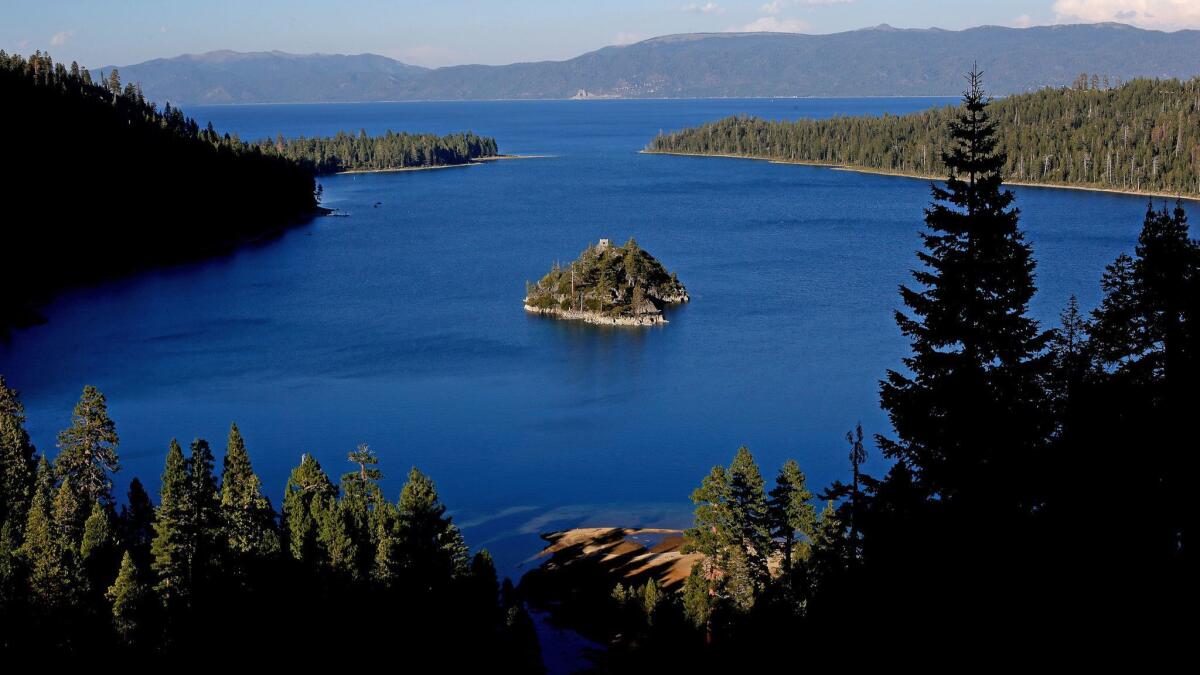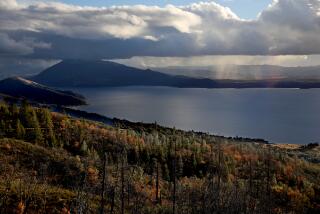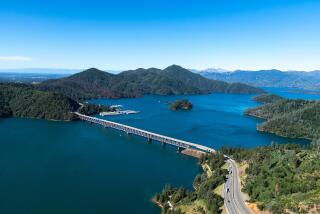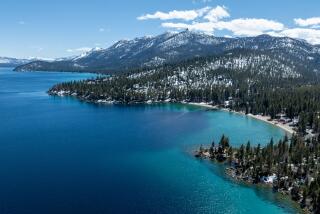Lake Tahoe’s cobalt blue waters have seen a stunning improvement in clarity

- Share via
The clarity of Lake Tahoe’s cobalt blue water improved dramatically in 2018, a year after the combined forces of historic drought and record-breaking rain resulted in the lake’s lowest visibility levels since record-keeping began in 1968.
Scientists measure water clarity by lowering a 10-inch-wide white disk into the lake and noting the lowest point at which the disk remains visible. In 2017, the disk was visible at an average depth of 60.4 feet — an all-time low.
But the lake bounced back in 2018. The average clarity from 26 readings taken throughout the year was 70.9 feet, according to the UC Davis Tahoe Environmental Research Center. The annual findings are typically released in the spring after the university analyzes the data it gathers each month in the previous year.
The five-year average for lake clarity is 70.3 feet, about a foot more than the previous half-decade marks, researchers said. Policymakers are hoping to restore annual clarity levels to about 100 feet.
Clarity measurements at Lake Tahoe have been recorded since 1968, when the disk could be seen at a depth of 102.4 feet.
Geoffrey Schladow, the director of the research center, said he was heartened by the results.
“Last year we had an anomolous situation,” he said. “We had an off year and the lake has the ability to recover very quickly.”
Scientists at UC Davis attributed the uptick in visibility to a return to more normal rainfall patterns in 2018. That led to a decrease in spring runoff and brought less fine sediment particles and nutrients into the lake.
The region had previously had a record wet year in 2017 — more than 50 atmospheric river storms emptied over the region — after years of extreme drought. Heavy rains flushed out hillsides and sent sediment from stream beds into the lake, scientists said.
The amount of silt that washed into the lake in 2018 was significantly lower — just 10% to 25% of what poured in the year before.
Lake Tahoe’s water tends to be the least clear in the summer after a typical snowmelt runoff, when warmer temperatures cause algae growth.
The biggest culprit is the phytoplankton species Cyclotella gordonensis, Schladow said. The microscopic algae, which has become more prevalent in Lake Tahoe in recent years, scatters light.
The lowest clarity recording last year was 50 feet in July, although the summer average between June and September was 61.7 feet. Clarity improved in the winter, with an average of 73.5 feet and one reading in March exceeding 100 feet.
Environmental advocates cheered the news but said work is still needed to reduce urban runoff from entering Lake Tahoe and to restore wetlands and forest habitat around it. UC Davis scientists said the lake was responding to such efforts and has seen an improved clarity trend over the last 20 years, compared to when record keeping began in 1968.
“For about 30 years it was almost a straight-line decrease,” Schladow said. “Since the late ’90s, that trend has changed. It is pretty flat. We are breaking that continuous downward trend.”
“We need to ensure Lake Tahoe is resilient to a changing climate where periods of drought followed by sporadic intense storms will be more common, if we hope to keep Tahoe blue,” said Darcie Goodman Collins, chief executive of the League to Save Lake Tahoe.
More to Read
Sign up for Essential California
The most important California stories and recommendations in your inbox every morning.
You may occasionally receive promotional content from the Los Angeles Times.











